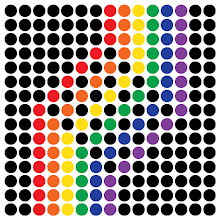UNESCO loves Berlin Bauhaus, Day 1
So, I read on Der Spiegel that UNESCO had recently classified a collection of 6 residential complexes as World Heritage Sites, in recognition of their importance for the Bauhaus school and Berlin Modernism. So, I decided that my task for today (aside from sleeping in) would be to find these buildings in Berlin, visit them, and bring back pictures of the sites.
Today is titled “Day 1,” because I sort of failed at the task and I’ll need to try again tomorrow. You see, the person who usually lives in the room I’m subletting was still here until today (he was crashing on the neighbour’s couch, I think), and so today he was frantically and belatedly preparing his luggage. Since he was running around the room and climbing over me to get his stuff into his luggage, I realized that I wasn’t going to get any studying/writing done, so I might as well be a tourist. Anyway, I looked up the 6 housing sites on the city hall’s website, wrote down the U-Bahn or S-Bahn stops as indicated on the site, and set off. What I failed to do was take detailed notes on where the buildings were in respect to the train stations, or at least find a street address. So, today’s results were spotty.
Hufeisensiedlung Britz : Win!
This complex, designed by Bruno Taut and Martin Wagner, was built between 1925-33 in the neighborhood of Britz, just south of Neukölln (i.e., just outside of Berlin proper). I managed to find this place rather easily, as the road that led to it was named after one of the architects and it came directly from the exit of the U-Bahn station. I managed to get a good number of shots of the place, although I had to adjust some of the photos later, as the really bright sun cast some harsh shadows.


The building is the shape of a huge horseshoe, and here are some pictures of the garden within:



Großsiedlung Siemensstadt : FAIL
The Berlin city hall website told me to get off at a certain U-Bahn station, while really I should’ve gotten off one stop earlier. I walked for about an hour around the Siemens plant and the nearby residential area (the housing complex is named after the massive Siemens plant), but I didn’t find anything that even remotely resembled Bauhaus architecture. Dejected, I headed back to the station and moved to my next assignment.
Weiße Stadt : Win!
Entitled the “White City,” the planning of this complex of buildings was overseen by Martin Wagner during the 20s, after WWI. I have to admit that this was one of the more boring of the housing complexes, as there was a near total absence of ornament or detail. On the other hand, as a project for creating lots of livable housing, I’m sure it was very welcome back in the 1920s.
I didn’t have an address for this place, but I was saved by the map in the U-Bahn station, which showed a nearby bus stop marked “Weiße Stadt.” I headed in that direction, and voilà!


Also, while I was in the neighborhood, I saw this building, which isn’t Bauhaus, but had a neat colour scheme. Alas, the odd lighting that day dimmed the colours.

Siedlung Schillerpark : FAIL
This time, I had gotten off at the right station, but the housing complex was on the other side of Schillerpark. In other words, I walked to within about 50 metres of the complex, then gave up and went back. Dammit.
On the upside, I saw this building, which had lovely decoration, rather art déco:

Wohnstadt Carl Legien : FAIL
Again, the same problem. This was one of the few places that I had actually looked up the address beforehand and marked on a map, but the address I had gotten was apparently of the nearest major intersection, and not the precise cluster of buildings. So I wandered up Prenzlauer Allee for a few blocks and saw nothing. There was this one very depressing yellow block building that was about as boring as the Weiße Stadt, so I took a couple of pictures of it just in case, but discovered as soon as I got home that I had the wrong place.
Gartenstadt Falkenberg : MISS
Considering that it was already 18h00 when I failed to find the last building, I decided to skip this one and add it to my assignment for tomorrow. Anyway, this building was the furthest from Berlin, in Grünau, nearly at the end of one of the commuter rail lines.




Aucun commentaire:
Enregistrer un commentaire